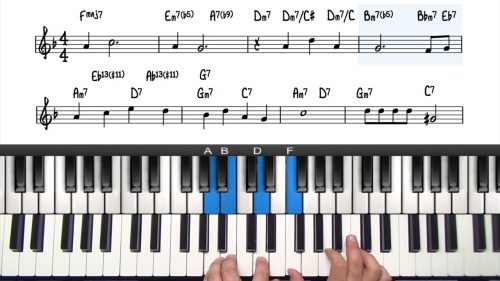Blues Scale Licks & Phrases
Welcome to the final lesson in our slow blues piano improvisation module which focuses on blues scale improvisation.
In this lesson, we aim to consolidate all of the ideas and concepts that we have covered in this course to enhance your improvisation skills over the slow blues in F.
Major vs. Minor Blues Scale
We start by making the distinction between the major blues scale and the minor blues scale and we discuss the notes and tones that are characteristic of each scale. The major blues scale can be seen as the major pentatonic scale with the b3, while the minor scale is comprised of the root, b3, 4, b5, 5, and b7.
After examining the notes of each blues scale we analyse the chords and harmonic situations to which they are most suited. The lesson guides you through transitioning smoothly between these 2 scales, especially between the chord changes F7, Bb7, and C7
A Varied Improvisational Vocabulary
Throughout this lesson we stress the importance of integrating various elements into your improvisation. These include chord tones, triad lines, 6th and 7th chord lines, chromatic passing tones, and space fillers. This will enrich your solos and prevent them from sounding monotonous.
A key point of discussion is avoiding over-reliance on blues scales to prevent limiting your improvisational abilities when playing slow blues piano.
Lesson Downloads
-
Minor Blues Scale Anticipation File Type: pdf
-
Blues Scales & Space Fillers File Type: pdf
-
Developing Strong Foundations Demo File Type: pdf
Practice Tips
-
Start by thoroughly learning both the major and minor blues scales. Understand their structure and the differences between them. Practice playing these scales in various keys until they feel natural under your fingers.
-
Don’t rely solely on the blues scales. Combine them with other improvisational elements such as chord tones, triad lines, 6th and 7th chord lines, chromatic passing tones, and space fillers.
-
Work on smoothly transitioning between the major and minor blues scales, especially over the 3 core chords in the 12 bar blues progression.
-
Experiment with hybrid scales where you blend elements from both the major and minor blues scales for a more diverse sound.
- Avoid overusing the blues scale. Practice creating solos without blues scales and then gradually incorporate them into your improvisations. This will help you use the blues scale more creatively in your improvisations.







